
John James Rickard Macleod,, was a Scottish biochemist and physiologist. He devoted his career to diverse topics in physiology and biochemistry, but was chiefly interested in carbohydrate metabolism. He is noted for his role in the discovery and isolation of insulin during his tenure as a lecturer at the University of Toronto, for which he and Frederick Banting received the 1923 Nobel prize in Physiology or Medicine. Awarding the prize to Macleod was controversial at the time, because according to Banting's version of events, Macleod's role in the discovery was negligible. It was not until decades after the events that an independent review acknowledged a far greater role than was attributed to him at first.
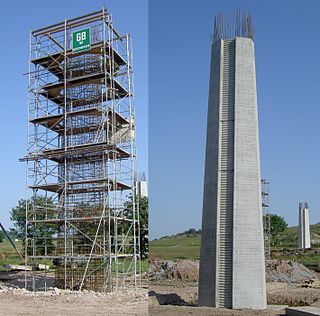
Reinforced concrete, also called ferroconcrete, is a composite material in which concrete's relatively low tensile strength and ductility are compensated for by the inclusion of reinforcement having higher tensile strength or ductility. The reinforcement is usually, though not necessarily, steel bars (rebar) and is usually embedded passively in the concrete before the concrete sets. However, post-tensioning is also employed as a technique to reinforce the concrete. In terms of volume used annually, it is one of the most common engineering materials. In corrosion engineering terms, when designed correctly, the alkalinity of the concrete protects the steel rebar from corrosion.

The University of Toronto Scarborough, also known as U of T Scarborough or UTSC, is one of the three campuses that make up the tri-campus system of the University of Toronto. Located in the Scarborough district, Toronto, Ontario, Canada, the campus is set upon suburban parkland next to Highland Creek. It was established in 1964 as Scarborough College, a constituent college of the Faculty of Arts and Science. The college expanded following its designation as an autonomic division of the university in 1972 and gradually became an independent institution. It ranks last in enrolment size among the three University of Toronto campuses, the other two being the St. George campus in Downtown Toronto and the University of Toronto Mississauga.
Frank Martin Baron served as professor of civil engineering at the University of California, Berkeley and held an international reputation as an expert in the fields of bridge and roof-structure design, and seismic and wind analysis. He was twice the recipient of the prized Leon S. Moisseiff Award issued annually by the American Society of Civil Engineers (ASCE), and among his manifold professional affiliations, served as chairman of the US Council of the International Association for Bridge and Structural Engineering.

Zdeněk Pavel Bažant is McCormick School Professor and Walter P. Murphy Professor of Civil Engineering and Materials Science in the Department of Civil and Environmental Engineering at Northwestern University's Robert R. McCormick School of Engineering and Applied Science.
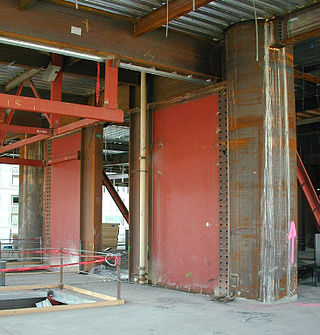
A steel plate shear wall (SPSW) consists of steel infill plates bounded by boundary elements.

Anastasios (Tas) Venetsanopoulos was a professor of electrical and computer engineering at Toronto Metropolitan University in Toronto, Ontario and a professor emeritus with the Edward S. Rogers Department of Electrical and Computer Engineering at the University of Toronto. In October 2006, Venetsanopoulos joined what was then Ryerson University and served as the founding vice-president of research and innovation. His portfolio included oversight of the university's international activities, research ethics, Office of Research Services, and Office of Innovation and Commercialization. He retired from that position in 2010, but remained a distinguished advisor to the role. Tas Venetsanopoulos continued to actively supervise his research group at the University of Toronto, and was a highly sought-after consultant throughout his career.

A T-beam, used in construction, is a load-bearing structure of reinforced concrete, wood or metal, with a T-shaped cross section. The top of the T-shaped cross section serves as a flange or compression member in resisting compressive stresses. The web of the beam below the compression flange serves to resist shear stress. When used for highway bridges the beam incorporates reinforcing bars in the bottom of the beam to resist the tensile stresses which occur during bending.
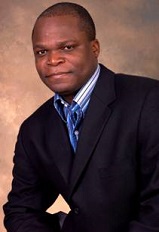
Mulalo Doyoyo is a South African engineer, inventor, and professor.
Mete Avni Sözen was Kettelhut Distinguished Professor of Structural Engineering at Purdue University, Indiana, United States from 1992 to 2018.
The modified compression field theory (MCFT) is a general model for the load-deformation behaviour of two-dimensional cracked reinforced concrete subjected to shear. It models concrete considering concrete stresses in principal directions summed with reinforcing stresses assumed to be only axial. The concrete stress-strain behaviour was derived originally from Vecchio's tests and has since been confirmed with about 250 experiments performed on two large special purpose testing machines at the University of Toronto. Similar machines have been built in Japan and the United States, providing additional confirmation of the quality of the method's predictions.

Arching or compressive membrane action (CMA) in reinforced concrete slabs occurs as a result of the great difference between the tensile and compressive strength of concrete. Cracking of the concrete causes a migration of the neutral axis which is accompanied by in-plane expansion of the slab at its boundaries. If this natural tendency to expand is restrained, the development of arching action enhances the strength of the slab. The term arching action is normally used to describe the arching phenomenon in one-way spanning slabs and compressive membrane action is normally used to describe the arching phenomenon in two-way spanning slabs.
Harold Malcolm Westergaard was a Danish structural engineer. He was Professor of theoretical and applied mechanics at the University of Illinois in Urbana and of Civil Engineering at Harvard.
Ifedayo Olawole Oladapo, OON, FICE, NNOM, was a Nigerian academic and professor of Civil Engineering at the University of Lagos.
Valery Samuilovich Shmukler was a Ukrainian engineer, an expert in the field of construction, reconstruction, the theory of structural systems, information technology, calculation and design of structures, and methods of optimization and rationalization of the scientific theory of rationalization building constructions. He was an academician of the Academy of Construction of Ukraine (1999), doctor of technical sciences (1997), professor (2001), winner of the State Prize of Ukraine in the Field of Architecture (1995), Laureate of the State Prize of Ukraine in the field of science and technology (2020), Honored Scientist of Ukraine (2015), emeritus professor of Kharkiv National Academy of Urban Economy (2014), chief of the department of building construction of Kharkiv National Academy of Urban Economy, a member of the International Association for Shell and Spatial Structures IASS (1980), and a member of the American Concrete Institute (1997).

Nemkumar Banthia FRSC, is an Indian-born Canadian engineer and professor of civil engineering at the University of British Columbia and the CEO of IC-IMPACTS. He is best known for his research in the fields of cement-based and polymer-based fiber reinforced composites, particularly on testing and standardization, fracture behavior, strain-rate effects, durability and development of sustainable materials.
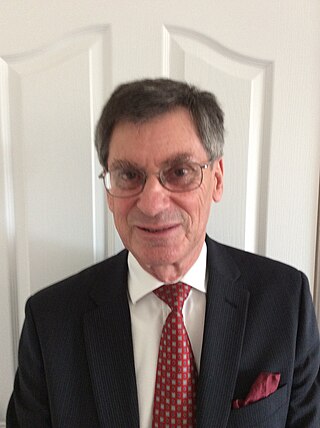
Leslie Arthur Clark OBE., FREng, FIStructE is a British structural engineer born in 1944 in Ilford, London.
Andrew Stuart Whittaker is an American structural engineer who is currently a SUNY Distinguished Professor in the Department of Civil, Structural and Environmental Engineering at the University at Buffalo, State University of New York.
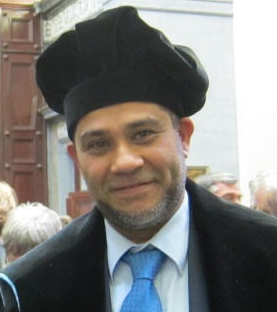
Magd Abdel Wahab is a Belgian academic, researcher, author and Imam of Islam. He is full professor and chair of applied mechanics at Ghent University, Belgium, where he is also the Head of Finite Element Modelling Research Group of Laboratory Soete.











